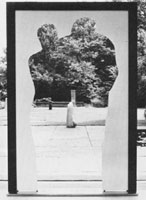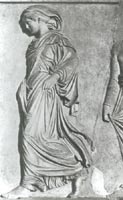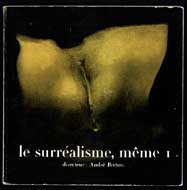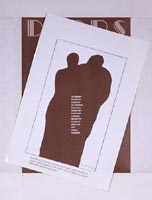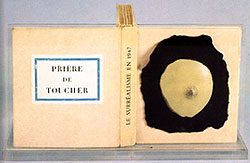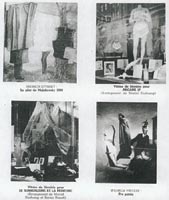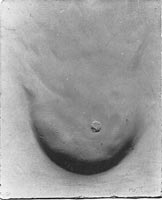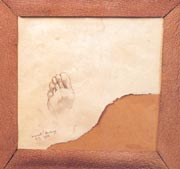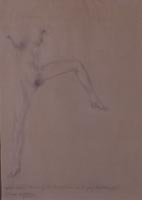by Thomas Girst
|
||||||||||||||||||||||
|
André Breton
We have to return to Duchamp's shoes. In the window display of 1945, they were neither all feet nor all shoes: Breton and Duchamp had collaborated many times before. Take 1937. Financially down on his luck and struggling to support his firstborn child, Breton was offered a gallery space by a generous friend for a few months. The original glass door (Fig.30) consisted of the incised outline of a couple through which the visitors could enter the gallery at 31, rue de Seine. Or, as Breton himself described Gradiva’s entrance: “You entered the store through a glass door that had been designed and executed by Marcel Duchamp, whose opening silhouetted, as their shadows might, a rather large man and a noticeably smaller and very slim woman, standing side by side" (20). Breton had borrowed the title of his exhibition space from a book by Wilhelm Jensen (1827-1911) of the same name, in which the archeologist Dr. Norbert Hanold falls in love with a young woman depicted on a Roman plaster relief from Pompeii, now in the collection of the Vatican (Fig.31). The descending female, longingly named Gradiva by the protagonist - originally translating into “she who walks” -, wears a long tunic exposing her beautiful bare feet clad in sandals. The erotically charged space between the sole and shoe is prominently featured throughout Jensen’s short novel written along the theme of cherchez la femme. It was no other than Sigmund Freud, admired by Breton and the Surrealists, who had written a long essay on Jensen’s book, annotating his copy of Gradiva with short notes about the meaning of dreams and foot fetishism (21). Duchamp was no stranger to this part of the female anatomy, as a friend of his remembered him during a tableau vivant at the Arensberg's a few years after Duchamp's arrival in New York in 1914: "A young Frenchwoman was reclining on a divan like a virginal Olympia while the male guests took turns stroking parts of her body. Duchamp was devoting himself to her legs, which he caressed with the tips of his fingers. [William Carlos] Williams watched the spectacle in awe: 'It was something I had not seen before. Her feet were being kissed, her shins, her knees […]'"(22).
Duchamp most certainly knew about Gradiva (23). When a long article on her appeared in the first issue of Le Surréalisme, même (24), it was Duchamp who designed the cover (Fig.32), choosing a photograph of the Female Fig Leaf, with the concave form appearing almost convex, the "coin sale", the Not a Shoe, in the center. There is yet another hint in all of this. Another version of the Gradiva door for Breton's gallery appeared much later. In 1968, for the announcement of the Doors exhibition at Cordier & Ekstrom, New York (March 19 – April 20, 1968), Duchamp produced miniatures of the door, both on paper and acetate (Fig.33). In addition, he created a “life-size” plexiglass replica of his Gradiva glass entrance. Two years after the completion of Given in 1966 and shortly before his death, Duchamp must have been amused at the exhibition’s theme of Doors, fully aware that Given, with its exterior consisting of a massive wooden Spanish door and an archway of red bricks, would be posthumously revealed to the public in the Philadelphia Museum of Art.
Enrico Donati
Not only did Duchamp and Donati collaborate in 1945 (25), but the window display for Breton's book was the first time that they worked together. Not even two years later, in mid-1947, Donati would assist Duchamp in his cover design for Le Surréalisme en 1947, a major exhibition of the movement held at the Galerie Maeght, Paris (July-August 1947). For each numbered deluxe edition of the catalogue (there were over 1000 of them), Donati and Duchamp would paste pink foam rubber-breasts, surrounded by a rough-edged circle of black velvet (Fig.34). Within the catalogue, plate XLI depicts four images, of which the lower left is a photograph of Duchamp's and Donati's window display of 1945 (Fig.35). The upper right image shows another window design by Duchamp of the same year, while the pictures by Surrealist painters Wilhelm Freddie and Jindrich Styrsky both depict half-hidden women. In Freddie's painting, the lower half of a what appears to be a clothed female whose body hangs outside a wall opening not unlike the brick wall of Duchamp's Given interior. The
back cover of Le Surréalisme en 1947 presents a sticker reading
Prière de Toucher or "Please Touch." (We are not too
far from Duchamp's miniature chicken-wire torso of 1943, his Twin-Touch-Test
for the back of VVV.) The abandoned plaster model for the breast
cover of the catalogue remained in the collection of Enrico Donati for
half a century. (It is now at the Philadelphia Museum of Art.) (Fig.36).
The model for this and a subsequent plaster was Maria Martins, Duchamp's
intimate friend (26).
The breast plasters are linked to the nude torso in Given, for
which Maria Martins was the first model. Yet another work by Duchamp
was in Enrico Donati's possession. An unnumbered Boîte-en-Valise,
just like Levy's, including another original art work mounted on the
lid's inside: a scrap of paper with a detailed drawing of the underside
of a human foot believed to be that of Maria Martins (Fig.37)(27).
In one of Honoré de Balzac's better-known stories, The Unknown Masterpiece
(first published in 1831) (28),
the otherwise successful artist Frenhofer struggles for years with a
canvas, yet coming up with nothing more than a mass of confused colors.
Almost nothing. Amidst the chaos, looking closely, an "enchanting,"
"living" and "admirable" female foot can be seen.
Though the first studies for Given show a standing female nude
with one foot raised at an awkward angle (Fig.38),
Duchamp leaves this part of the anatomy out of the final piece (29).
>>Next
Notes
26.
Casts
of breasts are nothing new in the history of mankind. In Gradiva's
hometown Pompeii, they were frequently used ex-voto in rituals.
See: Stefano de Caro, Il Gabinetto Segreto del Museo Archeologico
Nazionale di Napoli (Napoli: Museo Archeologico Nazionale, 2000,
p. 28). As good-luck charms, dildos and signs of economic well-being,
huge phalluses were also displayed prominently inside and outside many
houses and at funeral (Ibid.). As study models for artists or
intricate anatomical artifacts for scholars and doctors (mostly depicting
deformities), body parts, including both feet and breasts, were in frequent
use throughout the centuries (see: Horst Bredekamp, Jochen Brüning and
Cornelia Weber (eds.), Theatrum Naturae et Artis: Wunderkammern des
Wissens, Berlin: Henschel, 2000, pp. 197-218 [exh. cat.]). In New
York, during the late 1910s and early 20s, it was Duchamp-obsessed Dada-Baroness
Elsa von Freytag-Loringhoven who presented a plaster phallus to some
of her visitors (see Francis M. Naumann, New York Dada 1915-23,
New York: Abrams, 1994, p. 173). On the theme of plaster casts, it was
only a little later that the Parisian Bureau of Surrealist Research
suspended plaster models of nude women from its ceiling in 1924. It
was no other than Breton who oversaw the decoration (see: Mark Polizzotti:
Revolution of the Mind: The Life of André Breton, New York: Farrar,
Straus & Giroux, 1995, p. 220).
Figs.
30, 32-34, 36-38
|
||||||||||||||||||||||
